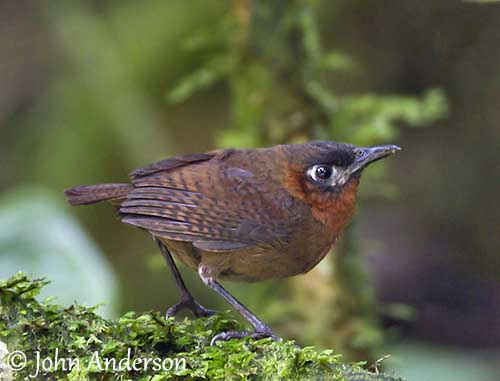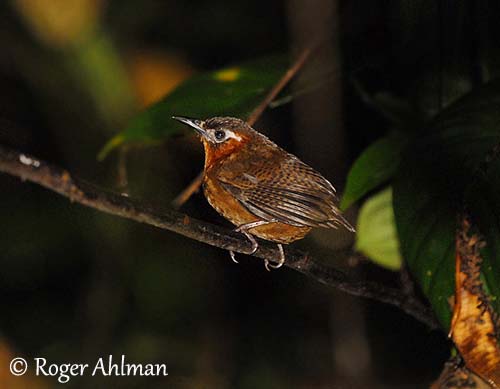
Fr: Troglodyte chanteur
All: Brillenzaunkönig
Esp: Chochín canoro, Chochín Cariazul, Colchonero cantor, Cucarachero Canoro, Cucarachero Gaitero, Soterrey canoro
Ita: Scricciolo canoro
Nd: Pacifische Orpheuswinterkoning
Sd: Sånggärdsmyg
Photographers:
Roger Ahlman
Pbase Galleries Peru and Ecuador
John Anderson
John Anderson Photo Galleries
Text by Nicole Bouglouan
Sources :
HANDBOOK OF THE BIRDS OF THE WORLD Vol 10 by Josep del Hoyo-Andrew Elliott-David Christie - Lynx Edicions - ISBN: 8487334725
WRENS, DIPPERS AND THRASHERS by Brewer David – illustrated by Barry Kent Mackay- Yale University Press - ISBN: 0300090595
A GUIDE TO THE BIRDS OF COLOMBIA by Steven L. Hilty and William L. Brown - Princeton University Press – ISBN 069108372X
A GUIDE TO THE BIRDS OF MEXICO AND NORTHERN CENTRAL AMERICA by Steve N. G. Howell, Sophie Webb - Oxford University Press - ISBN: 0198540124
BIRDS OF SOUTH AMERICA – Passerines - by Robert S. Ridgely and Guy Tudor – HELM Field Guides – ISBN: 9781408113424
BirdLife International (BirdLife International)
Neotropical Birds – Cornell Lab of Ornithology
Song Wren
Cyphorhinus phaeocephalus
Passeriformes Order – Troglodytidae Family
INTRODUCTION:
Its scientific name describes a part of the Song Wren, talking about the arched culmen and the dark head. But this small bird is mainly renowned for its melodious song, similar to pan pipes’ notes. The Spanish name “Canoro” means “melodious singer”, and the Song Wren is a remarkable singer!
It commonly frequents the understorey of humid forest where it is difficult to see this bird.
DESCRIPTION OF THE BIRD:
Biometrics:
Length: 13-15 cm
Weight: 24-25 g
The adult male of nominate race has rich dark brown upperparts with faint darker barring on upper and middle back. On the wings, primaries and secondaries show barred orange-brown and dark brown outer webs. The short tail feathers are dark brown with blackish barring.
On the underparts, chin, throat and breast are warm orange-brown, whereas breast sides and belly are medium-brown. There are sometimes some white feathers on belly.
On the head, the crown is blackish brown, including the lores. The ear-coverts and the area behind the eye are warm orange-brown. The eye is surrounded by greyish-white to flesh-coloured bare skin, with some blue tinge at rear of the eye.
The black bill has compressed base and arched culmen. The eyes are brown. Legs and feet are greyish-brown.
Both sexes are similar, and the juvenile resembles adults, with variable amount of white on the throat.

SUBSPECIES AND RANGE:
We can find six subspecies.
C.p. richardsoni occurs in the Caribbean lowlands of SE Honduras and E Nicaragua. This race has more brightly rufescent rump.
C.p. infuscatus is found in the Caribbean lowlands of Costa Rica and NW Panama. This race is darker with more distinctly black crown.
C.p. lawrencii is found in Panama (except NW) and extreme NW Colombia (Golfo de Urabá). This one has rufous throat contrasting with paler breast.
C.p. propinquus occurs in the tropical lowlands of NW Colombia. This race is paler above and below, with stronger contrast between throat and breast.
C.p. chocoanus occurs in W Colombia, S to N Chocó. This race is darker than nominate, with blackish crown, chin and malar area. Breast and belly are similarly coloured.
C.p. phaeocephalus (here described and displayed) occurs in W Colombia (S Chocó), S to S Ecuador (El Oro).
HABITAT:
The Song Wren frequents the understorey of humid lowland forest and wet second growth woodland. This species is visible from sea-level to 700 metres of elevation, sometimes higher, up to 1000 metres.
CALLS AND SONGS: SOUNDS BY XENO-CANTO
The Song Wren’s calls are harsh and frog-like. The alarm call is a series of harsh “churr”.
The song is a medley of harsh “chowk chowk-a-chowk chuck” sounds, interspersed with clear, melodious, rising and falling flute-like whistles sometimes varying in pitch.
The pair sings antiphonally, with each bird uttering its own motif of clear whistled notes. The combination of both songs involves a complex pattern of repeated notes, mixed with harsher “chowk chowk” notes. But such song often seems to be the product of a single bird.
BEHAVIOUR IN THE WILD:
The Song Wren feeds on terrestrial invertebrates such as small insects and spiders. It sometimes follows ant swarms.
It forages on the forest floor by probing into the leaf litter or on fallen logs.
They live in family groups of 2-5 birds almost all year round. The offspring may remain for about 4 to 18 months with their parents, but they do not take part in any nesting duty. They roost in nests, in groups of 5-6 birds.
The Song Bird maintains and defends a stable territory all year round. They are monogamous. However, a mature female usually leaves a mate after several successful breeding seasons, even when an alternative partner is not available.
Territorial defence and breeding are usually associated with aggressive behaviour. During the threat displays, the bird spreads the wings while the partially fanned tail is drooped. The bill is pointed towards the opponent. But physical fights are uncommon.
During courtship displays, the tail is usually cocked over the back. Information is lacking, but we can suggest that the orange-brown chin, throat and breast are enhanced by adapted postures and movements, as the peculiar head pattern too.

The Song Wren is sedentary in its range.
The rounded wings indicate short flights in dense vegetation rather than long flights.
REPRODUCTION OF THIS SPECIES:
The breeding season occurs between January and May, but it may vary slightly according to the range.
The Song Wren’s nest is boomerang-shaped. This is an untidy structure with a tubular, downwards-sloping side entrance. There is an enclosed nesting chamber on the opposite side. It is made with fibrous roots and pieces of leaves. It is built over a thin branch, often in Acacia trees where aggressive ants provide a natural protection against predators.
The female lays 2-3 white eggs with brown markings. There is no information on incubation and fledging period, but usually in Troglodytidae species, the incubation lasts between 12 and 20 days, and the young fledge 12-18 days after hatching.
In this species, the young birds remain with their parents for several months.
PROTECTION / THREATS / STATUS:
The Song Wren has large range in which the species is relatively common. Destruction of the habitat and fragmentation could be the causes of some decline in several areas.
However, the Song Wren is not currently threatened.